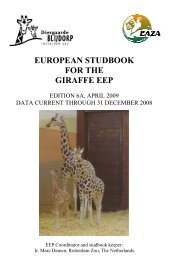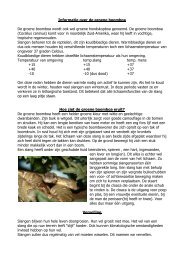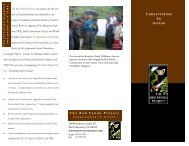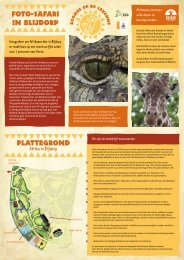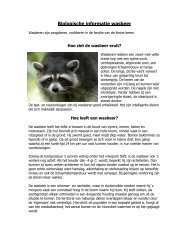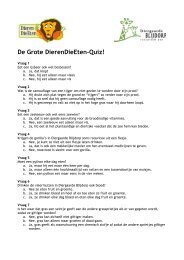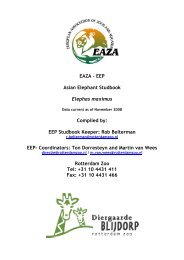Create successful ePaper yourself
Turn your PDF publications into a flip-book with our unique Google optimized e-Paper software.
<strong>EEP</strong> STUDBOOK CROWNED PIGEONS<br />
The egg produced by scheepmakers crowned <strong>pigeon</strong> is about 52.0 x 37.5 mm (Coates, 1985).<br />
Both birds incubate the egg and they relieve each other at about 24 hours. The male takes a<br />
full share of parental duties. Both sexes incubate and brood for about the same <strong>number</strong> of<br />
daylight hours, both produce crop milk and feed the young (Goodwin, 1983). Crop milk is a<br />
white, slimy caseous material formed by the desquamation of epithelian cells in the crop<br />
(Davis, 1939, in Clawitter, 1990). Incubation time in all three species is about 28 (Fleay,<br />
1961) till 30 days (Klös, 1966; Assink, 1988). Assink studied the incubation time in captivity<br />
by sending questionnaires to zoos. He found a range of 22 - 39 days in victoria crowned<br />
<strong>pigeon</strong>s and 26 - 32 days in scheepmakers crowned <strong>pigeon</strong>s. This can be explained by the fact<br />
that the bird keepers do not check the nests of eggs and hatchings every day, to not disturb the<br />
birds.<br />
<strong>Crowned</strong> <strong>pigeon</strong>s are a very hygienic species. Just like other ground-<strong>pigeon</strong>s, which do not<br />
nest on the ground, they always keep their nest clean. Their nest sanitation might serve to<br />
make the nest and young less conspicuous or odiferous to potential predators and / or to keep<br />
the nest in a condition where it will quickly dry out after rain.<br />
The parents seldom leave their eggs, chick alone unless the incubating parent is forced to flee<br />
from the nest (Goodwin, 1983). In Burgers' Zoo the crowned <strong>pigeon</strong>s were housed with<br />
hundreds of other animals in a huge eco-display (90 x 130 m). A pair of blue-throated pipingguanas<br />
(Pipile cumanensis) lied in wait for the egg and because of this threat the crowned<br />
<strong>pigeon</strong>s procrastinated the relief. They relieved each other very careful and sometimes the<br />
crowned <strong>pigeon</strong>s were even sitting together on the nest to protect the egg against the guans.<br />
Thanks to the very careful and active parent, who will both feed the chick (the first days with<br />
their crop-milk, later with other food), the chick will gain weight very fast, although<br />
according to other sources the development of the chick is very slowly in comparison to other<br />
Columbiformes (King and Nijboer, 1994). Two weeks after birth, the chick is already<br />
completely feathered. It fledges after about 28 to 30 days (AZA, 1996). Assink found in the<br />
responses to his questionnaire also a lot of variation: common crowned <strong>pigeon</strong>s 28 - 40 days,<br />
victoria crowned <strong>pigeon</strong>s 20 - 31 days and scheepmakers crowned <strong>pigeon</strong>s 27 - 30 days<br />
(Assink, 1988). Apart from false records because of not exact and very few data, it is expected<br />
that there is more variation in fledging time, because of more external influences, like food<br />
composition, temperature, threats and of course both parents.<br />
Pigeons learn to recognize their young as individuals about fledging time. Therefore, a young<br />
crowned <strong>pigeon</strong> taken from the nest by human beings, will preen on men in stead of on other<br />
crowned <strong>pigeon</strong>s and it will never produce a chick of its own (Goodwin, 1983).<br />
In comparison to fruit <strong>pigeon</strong>s (who fledge after 12 days), this is extremely late (Goodwin,<br />
1983) As the young crowned <strong>pigeon</strong> fledges, it is about one third of his parents size. Firstly it<br />
is completely fed by his parents, but after a few days on the ground, it starts looking for its<br />
own food little by little. Two or three months after fledging, depending on the behaviour and<br />
care for the young, the parents pay less attention towards the young bird (King and Nijboer,<br />
1994). Fleay reported that a victoria crowned <strong>pigeon</strong> fledged at four weeks old when it could<br />
fly very well although only about a quarter the bulk of the adult. It was fed by the parents<br />
until 13 weeks old. Sometimes the crowned <strong>pigeon</strong>s start breeding again in captivity and in<br />
this way a pair of crowned <strong>pigeon</strong>s can raise up to three chicks per annum. Adult birds are<br />
capable of recycling within 14 to 30 days after losing an egg (AZA, 1996), when the egg is<br />
infertile, the hatching dies of fledges (Assink, 1988).<br />
116



